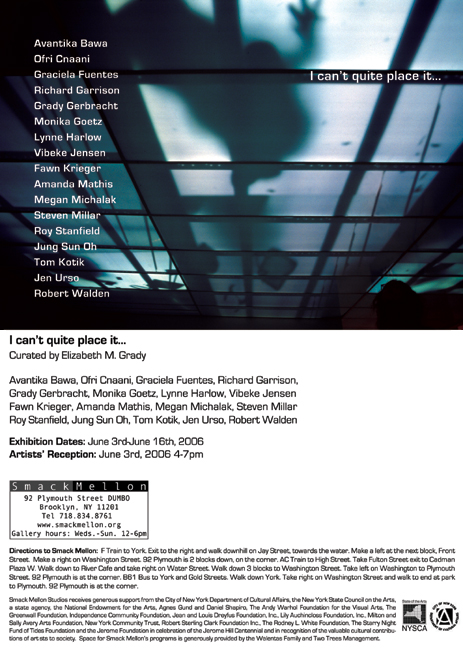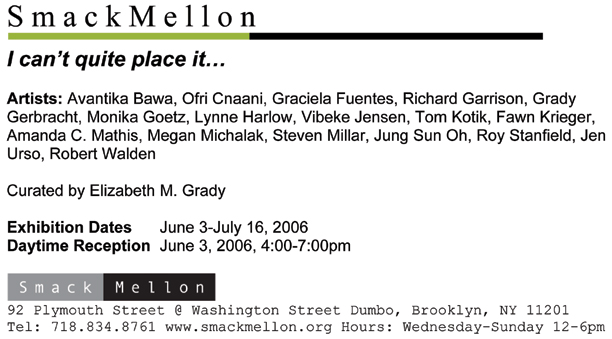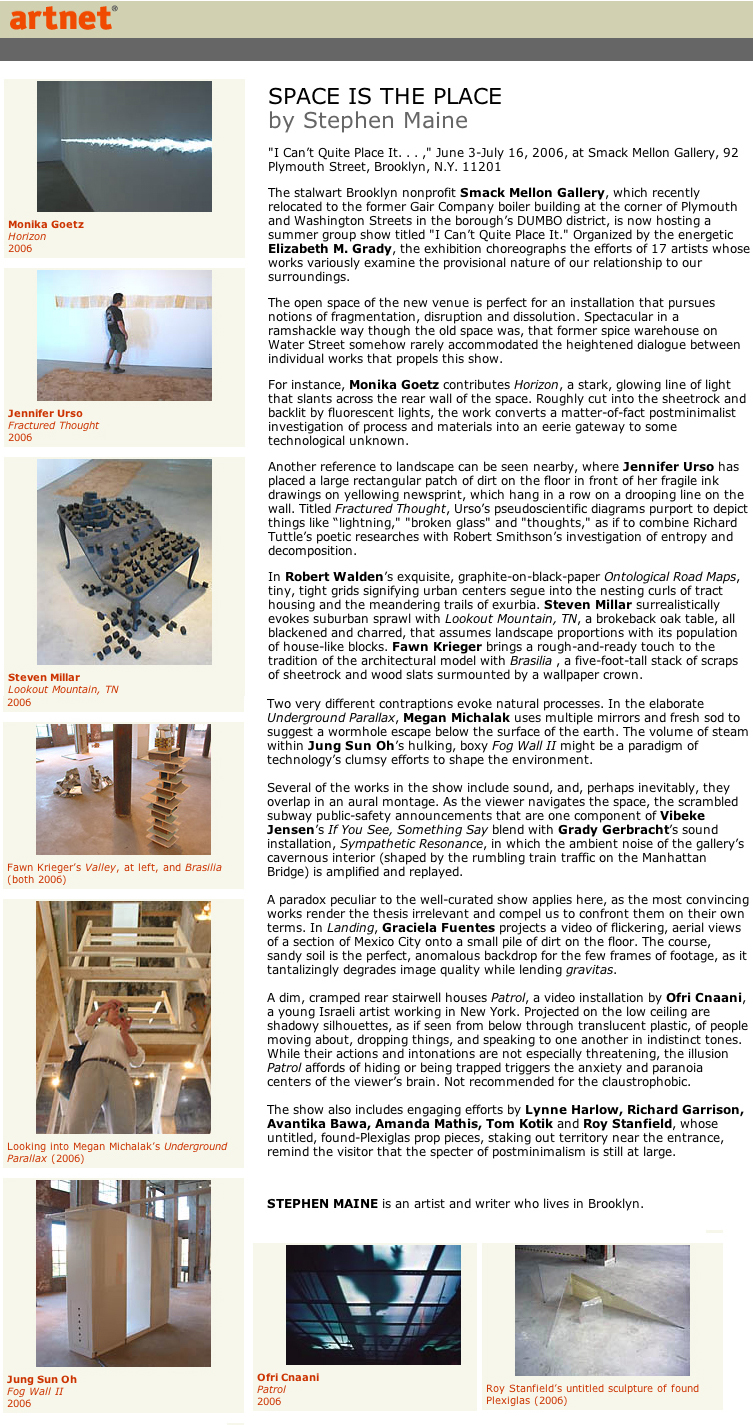

Using unusual approaches to navigating spaces and occupying places, the seventeen emerging artists in I can't quite place it… radically alter their environments, transforming them in an effort to subvert structures both architectural and social. Their widely varied approaches to the subjective perception of a place and its impact on the individual will include video, sculpture, drawing, and ten new site-specific installations.
Practicing an intuitive rearrangement of the visual information encountered in the course of an average day, the artists toy with the structures of power and human interaction encoded in space, borrowing from the architecture of Smack Mellon's new site, as well as the very energy of the gallery itself in the form of light, sound, and time. They lead us along from image to idea, following a trajectory of free-associations, and creating a discontinuous mosaic of temporal perception in contrast to the more commonplace linear narratives associated with Western culture.
Each of the artists in this show responds to the specific architectural structures and histories of the sites in which they install their work. Experience comes in flashes and streaks, seams and ruptures rather than an unbroken line. They believe that it makes more sense to record experience abstractly than to make of it something explicit and delimited. Open-ended meanings are preferable to fixed and closed ones, allowing the opportunity for varied responses and spontaneous reactions. In this way these artists encourage the viewer to share in their intuitive approaches.
Although individually these artists may or may not view their work as political, their creation of a liminal space, an unfamiliar realm where some of the rules and restrictions of everyday life are relaxed and replaced by different norms of behavior provides a model for intellectual freedom. Perceiving the urban environment on their own terms rather than those dictated by the structures and practices of society is a way of undermining the constraints and oppression associated with institutions, and established systems of power .
In the delicate and cerebral architectural interventions of Avantika Bawa cardboard and Styrofoam are used in the service of breaking down the barriers between sculpture and drawing, and treading the line between wholeness and fragmentation, containment and dispersal. Drawing on the legacy of Minimalism, her work responds to its context, inviting viewers to experience it as they move through it, over time.
In Patrol (2003/06), Ofri Cnaani projects video footage of menacing footfalls overhead, creating an uncanny sense of physical dislocation which raises our awareness of the psychological qualities inherent in the construction of space, and the social impact of the exercise of authority. The projection surface divides us from direct interaction with the walkers, creating a dynamic tension between their freedom of movement and our compromised viewing position, which mirrors our subjection to often invisible structures of power.
Occupying the liminal space of passage that occurs in the airspace above cities, Graciela Fuentes' video installation Landing (2004/06) places us in an airplane above Mexico City. The video loop cuts back and forth between clips of approach and takeoff, never permitting arrival or departure. Leaving us in limbo, she tantalizingly references the importance, yet ultimate impossibility, of rootedness to place by projecting the video onto soil.
Richard Garrison navigates suburban sprawl, with its winding roads, vast parking lots, and "big box" stores like Wal-Mart, recording the experience in drawings and installations. By focusing on the experiential phenomena of those sites like color and light, rather than their intended use and function, he questions their impact on the individual psyche, and highlights the choices available as we avoid, move through, and occupy them in the course of our weekly routines.
Working in sound, performance, and installation, Grady Gerbracht renders systems of social behavior temporarily visible in his "sonic portraits". He interacts deeply with specific spaces, contributing to and revealing their ambient noises, and recording and amplifying the results. This exposes often undervalued aspects of our emotional, physical, and intellectual responses to the environment and can indicate hitherto underappreciated strata of social meaning encoded within it.
Horizon (2005), a violent gash of searing fluorescent light that is exposed when the artist cuts through a section of drywall, disconcerts the viewer as it partially dematerializes its environs. In this piece, Monika Goetz plays with our reliance on the solidity, stability, and reassuring regularity of walls. Equal parts beautiful and disturbing, this work has a profound emotional impact as one struggles with the notion that the walls that comprise our shelters and workplaces are flimsy, permeable, and ultimately unreliable.
Addressing the nature of perception and our movement through space through their insistently human scale, installations by Lynne Harlow have a formalist elegance that belies their sophistication. By reducing her interventions to simple geometric forms comprised of painted surfaces and light, permeable materials like fabric scrims, and hardware cloth, she creates a weightless atmosphere suffused with light.
Harsh whispers and enigmatic announcements create a feeling of threat and bewilderment in Vibeke Jensen's If You See, Something Say (2006). By editing and rearranging the wording of phrases heard over the loudspeakers on the subway, along with inviting the public to use a microphone to explore the relationship between silence and control, Jensen challenges the experience of being subject to disembodied forces beyond our control.
Tom Kotik embeds references to sound in architectural frameworks, which sometimes make noise, and are sometimes menacingly silent. Low frequency, inaudible music makes an audio speaker pulse, and acoustic foam threatens to drain the sonic energy from a space, creating an "Architecture of Silence" that suggests the repression of freedom of speech in countries ruled by totalitarian regimes - or here at home.
Fawn Krieger unfolds an overlapping territory between personal and collective space, collapsing expectations of scale between body and site. Working with mundane materials and processes like carpentry and sewing, traditionally associated with craft and the construction of the home, she uses an intimate vocabulary of comforting familiarity, as well as traces of memory, loss, and the nature of social behavior.
Tilting the world on its end, Amanda C. Mathis reproduces and reorients elements of the architecture in which her work is sited. We are thwarted in our efforts to follow the expected path through the gallery by the hulking presence of new walls and windows, and dragged temporarily out of our heads and into our bodies as we interact with the daunting physical presence before and around us.
Upon entering a low passage in Megan Michalak's Underground Parallax (2006), the viewer confronts a mirror reflecting an infinite wooden catwalk leading backwards and upwards into space, and towering over the installation. The piece acts metaphorically to recall the "underground" as a historical site of resistance and liberation even as the endless path before us offers an exit from the exhausted social structures of late capitalism.
In Chattanooga, Tennessee, the suburbs crawl up Lookout Mountain, which rises on the edge of the city. The ominous presence of the eponymous work by Steven Millar is created mainly by the rough and crumbly surface of its burnt-black oak material. It richly signifies everything from the disposable nature of much suburban construction, to racial and social issues of access to this dubious iteration of the American Dream.
Exploring the link between visibility, perception, and communication, Jung Sun Oh has built a Plexiglas structure containing a fog that slowly thins from opaque to translucent. As the viewer enters the fog chamber, there is a struggle to make visual connections with those outside. Our awareness of invisible barriers to interchange like language and culture is heightened by the minimal, wall-like form of the chamber.
The precarious relationship between ephemerality and presence found in the disregarded but by no means vacant lots and marginal spots found everywhere in the urban environment is explored by Roy Stanfield in his Plexiglas sculptures. Threatening to disappear into the gallery space, still they catch the light and govern traffic patterns in a way that challenges the notions that what is discarded is lost, and that an object once robbed of functionality also loses its meaning, energy, and significance.
Jen Urso is concerned with systems: systems of ideas, social interaction, decay, and growth. Elements of her work break down, like the trains of thought she transcribes in her diagram-like drawings or the slowly disintegrating concrete and clay tiles she places in our path. But in sympathy with the Law of the Conservation of Energy, the breakdown releases energy to form new patterns, and to facilitate change.
The marks of shimmering graphite made on the matte-black paper ground in Robert Walden's Ontological Road Maps suggest aerial views of elaborate urban zones, complete with housing developments, industrial areas, and business districts. The artist's experience of making is parallel to that of viewing the works, each requiring a navigation of the city's frustrating pattern of loops and culs-de sac over time. In this way we are reminded that the state of being is found at the intersection of temporal position, physical location, and state of mind.
Smack Mellon receives generous support from the City of New York Department of Cultural Affairs, the New York State Council on the Arts, a state agency, the National Endowment for the Arts, Agnes Gund and Daniel Shapiro, The Andy Warhol Foundation for the Visual Arts, The Greenwall Foundation, Independence Community Foundation, Jean and Louis Dreyfus Foundation, Inc., Lily Auchincloss Foundation, Inc., Milton and Sally Avery Arts Foundation, New York Community Trust, Robert Sterling Clark Foundation Inc., The Rodney L. White Foundation, The Starry Night Fund of Tides Foundation and the Jerome Foundation in celebration of the Jerome Hill Centennial and in recognition of the valuable cultural contributions of artists to society. Space for Smack Mellon's programs is generously provided by the Walentas Family and Two Trees Management.
Directions to Smack
Mellon:
F Train to York. Exit to the right and walk downhill on Jay Street,
towards the water. Make a left at the next block, Front Street. Make
a right on Washington Street. 92 Plymouth is 2 blocks down, on the corner.
AC Train to High Street. Take Fulton Street exit to Cadman Plaza W.
Walk down to River Cafe and take right on Water Street. Walk down 3
blocks to Washington Street. Take left on Washington to Plymouth Street.
92 Plymouth is at the corner. B61 Bus to York and Gold Streets. Walk
down York. Take right on Washington Street and walk to end at park to
Plymouth. 92 Plymouth is at the corner.
